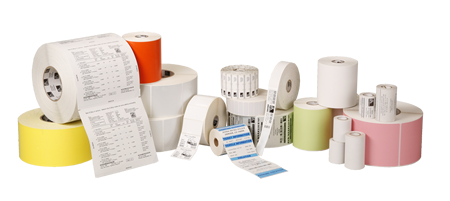Selecting the appropriate barcode supplies for your company can be an overwhelming task. There are hundreds of options out there for you, but how can you narrow it down to a more manageable search? These simple steps will help you identify the right barcode supplies for your printing needs.
- Identify your printer type.
Before you consider any type of barcode supplies, you first need to understand the barcode printer that you’re working with. This will ensure that your supplies are compatible with the printer model. Identify the brand, model, and technology that you use.
- Consider the application the label will be used for.
The kind of label you choose will be based directly on the environment it will be used in. Will you need a simple product label? Do you need something more durable? Or maybe you need a wristband for patient use? Asking how the barcode supplies will be used helps to narrow down the many options.
There are three main types of barcodes—labels, tags, and wristbands. Labels are most common, and refer to the standard sticker-type media used to adhere directly to an item. Tags are slightly different. They lack adhesive and are attached by strings or staples, like for clothing hang-tags. This type of barcode is useful when you want to be able to remove the barcode from an item without leaving any sticky adhesive residue. Finally, wristbands are used when tracking people, like patients in a hospital or nursing home.
- Find the media you want to use.
Once you’ve decided how you’ll be using your barcode supplies, you’ll want to consider the media of the barcode—paper, polypropylene, or polyester? Taking a look at the environment of your barcode supplies will help you decide on the most appropriate media.
Paper is the most common medium for barcode supplies, because it’s low cost and easy to use. Paper works best in dry, indoor environments. It also works well for temporary tracking, like product shipping. Thermal transfer printers that are using paper media will require a wax ribbon.
Polypropylene is a plastic material that’s best suited for environments that require more durability. This medium is resistant to water and tearing, but wouldn’t be appropriate for situations where abrasive chemicals could contact it. If you go with polypropylene in a thermal transfer printer, you’ll need a wax or resin ribbon.
For more extreme uses, polyester may the necessary medium for your barcode supply needs. Although it is the more expensive option, it can be used outdoors and in harsh conditions. It’s often used for tagging vehicles or where the tag could be exposed to chemicals. This option is rarely available with direct thermal printers. Thermal transfer printers using polyester barcode supplies will need a full resin ribbon.
- Choose the size of your label.
Next you’ll need to identify the most appropriate size for your barcode supplies. This will depend on a variety of factors. If you are attaching the barcode to a small item, you’ll want to be sure it fits. If you are using the barcode to identify items from a distance, you may need a larger barcode.
Identifying these key areas for your barcode supplies will help you narrow down the many options available to you. If you’re still not sure what barcode supplies are best for you, try using Zebra’s Barcode Supplies Finder Tool. This tool will help you identify the printer, media, technology, and size you need. By exclusively ordering Zebra barcode supplies, you may also qualify for their Printhead Protection Program, where you can receive replacement printheads for no charge.




